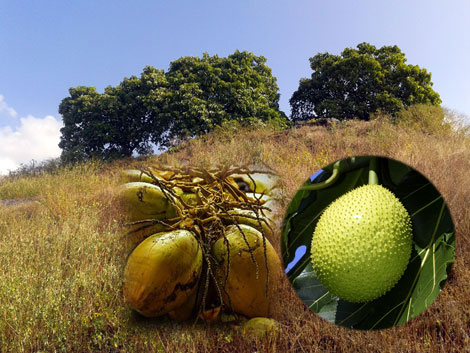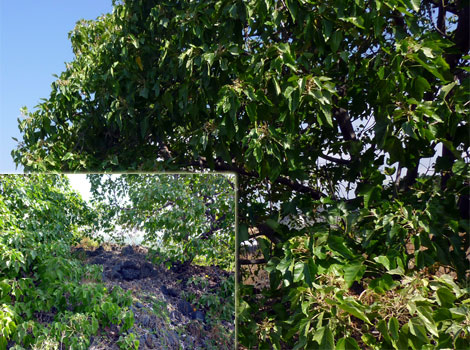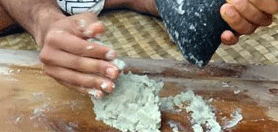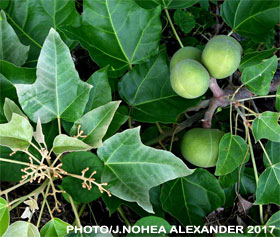
History of Keaukukui`ula Heiau
We have created this page to provide a living history of Heiau Keaukukuiula in order to bring a greater understanding and appreciation of this sacred preservation site. Details of its history are on-going so we will be updating this website with current/updated information as we discover them. We hope you enjoy the heiau's history and continue to support its preservation and historical significance. A special mahalo nui loa to writer, Kate Kealani Winter, as well as the Heiau Keau Kukui Ula Preservation Committee, and relevant others for providing or assisting in the narrative and research of the following information.
Article 1 - Keaukukuiula Heiau - Where and what is it?
On a bluff above the Queen Ka`ahumanu Highway just below the village of Holualoa (Kailua-Kona, HI) sits one of the ancient heiau or temples of old Hawai`i.
Today a small cluster of kukui trees with their distinctive silvery-green foliage marks the heiau from the makai side, but ages ago it would have been easy to see from Kailua Bay--Kamakahonu--when the court of Kamehameha I lived at the bay. Now the trees and a wrought iron fence mark the crest of the hill and partially obscure the coastline from Keauhou to Kaiwi that kahuna would have seen. This precious parcel between Paulehia Street and North Haku Mele Place was recently given over to the Home Owner's Association of Pualani Estates for preservation and interpretation and is being curated by a committee of homeowners who are committed to the protection of the site.
Looking at the heiau today, one might imagine that its features were typical of other heiau in the Islands: level terraces of different elevations paved with dirt, sand or flat stones, perhaps an enclosing wall, a hale to store the ceremonial drums and the idols and carved images. Keaukukuiula was roughly rectangular, layered with three tiers at the top of the knoll and one tier descending the southwest slop. Pit-like depressions near the east end may have supported wooden images. There were also ahu`ilina. A very old map shows a raised kahu where a lele stood and at least two caves within the heiau boundaries. There were three narrow entrances and a front area paved with pahoehoe rock. Because of its size (roughly 18,689 square feet), terraces, and placement in the district, scholars and experts believe it was a temple of Lono.
Article 2 - Keaukukui`ula - The Heiau and the `Aina
The heiau was built in the distant past as a mapele, a temple dedicated to the Hawaiian god Lono. It is likely that pigs, dog, fish or vegetables were offered here to ask Lono's blessing on crops in the district. Archaeological evidence reveals that the people who lived in this part of the dry uplands were farmers, cultivating the roughly 3 by 18 mile swathe of fields that made up what became known as the "Kona Field System" that was well-established by the 14th Century AD. After Kamehameha I returned to Kona from O`ahu in 1812, the area became a busy royal center. However, the king and court found a scarcity of cultivated food because lesser chiefs had ordered all the people to harvest sandalwood from the highlands for the lucrative export business instead of tending their fields and gardens. Kamehameha I revived the field system and it once again fed the substantial community of commoners and ali`i who occupied this part of Kona.
In 1779 a ship captain had observed that "not the smallest piece of ground was left uncultivated" here. North Kona also had a wealth of fishponds, deep sea fisheries, and other marine resources, and there is also a documented fishing heiau near the shoreline in the same ahupua`a of Puapua`a. The fishermen and women provided ocean and shore products, and the bulk of the protein for the Hawaiian diet while upland agriculture completed the balance with staple fruits and vegetables, and supplemental crops such as fibers for weaving. Indeed, Kona was famous for its wauke, the raw material for kapa cloth, and olona for cordage.
Article 3 - Keaukukui`ula - Why "Kukui"?
Lono was "the father of the waters," and thus the deity over-seeing agriculture, fertility and rainfall. In North Kona, where there are no perennial streams, water was provided by springs of punawai, water caves, rain catchment and kehau, wind-borne dew, making this kula or dry land district.
The kukui included in the name of the heiau was important to people here because its leaves were used for mulch to hop moisture in the cultivated rock piles in such land and was very tolerant of drought. In addition, the nuts of the kukui tree were used for light and worn by ali`i as a symbolic lei of light to honor Lono, and show their status as royalty.
Other uses of the tree included healing oil, waterproofing for fishnets, red dye for tapa and fishnets, and a condiment with poi. The heiau was first used between AD 420 and 660, and by AD 1000 the area was inhabited abundantly and the land used as a "garden" to feed the large Hawaiian population. Through management of the resources of Kona, the people were able to supply sweet potato, sugar cane, bananas, breadfruit, coconut, and on the upper slopes of Hualalai the olona for cordage, `awa for ceremonial and domestic use, and wood from the upland forests.
Article 4 - Keaukukui`ula - Ancestors and Descendants
Heiau or temples were important to the people of Hawai`i because every aspect of life depended on the bounty of the earth, so everything Hawaiians did connected them to it with respect and veneration. Maka`ainana (people of the land) were often buried where they lived and near and within heiau. The bonds of gods, nature, bone and ancestral spirits provided identity and the promise of sustenance and abundance. Living among the bones of their ancestors and kupuna allowed them to commune with them as they went about their daily lives. Burials represent the trusted web of ancestral mana, the powers of the gods, the environment, and faith in the future.
The curatorial committee for Keau Kukui`ula Heiau is searching for lineal descendants of the people who used the heiau. Using documents and testimony from the time of the Mahele, a tentative list of family names has been developed and includes:
Kaiewe
Kawainui
Kaihu
Keliikanakaole
Ikeole
Keawe
Kala
Lalimapaa
Kauila
Wm. C LunaliloIf you have information about any ohana or families who may have been connected to the heiau, please get in touch with the Pualani Heiau Preservation Committee so that we can continue to develop the history and interpretation of this sacred site in Pualani Estates.
Article 5 - Naming The Heiau - Why "Kukui"?
What does the name Keaukukui`ula tell us about the heiau in Pualani Estates at Kona? Literally, it means “the sacred kukui red.” The kukui or candlenut tree was very important to the Hawaiian people. The presence of the beautiful gray-green trees on the ridge of the heiau today connects this place to the agricultural significance and sacredness of the heiau itself.
Parts of the kukui were important in everyday life in ancient times. The many uses of the kukui included the nuts being strung together on plant fiber (usually palm rib) and lit to create a light as the fire burned through each nut. People could tell time by how many nuts had burned through, for example telling someone to be back at home by the time three nuts had finished burning. As a fishing tool, the oil of the nut was spat on the water to make a smooth “window” into the water below to aid the fisherman in finding the right fish. For food, the ground, roasted nuts were mixed with salt to make a granular condiment called inamona to eat with fish and poi.
Medicinally, the oil of kukui nuts was an effective remedy for stomach and intestinal problems. The bark and nuts of kukui trees also provided dyes: The inner bark of the tree trunk made a splendid red dye for tapa while the dried soot of the burned nut was the best source of the black dye used for tattooing.
The kukui tree is a clear example and reminder of how the people of old Hawai’i used their natural resources as completely as possible. The trees’ presence supports our understanding of Keaukukui’ula as an agricultural heiau. The graceful trees that stand today are symbols of the powerful connection the Hawaiians had with the land, the water, and the plants that sustained their way of life.
Article 6 - Kukui and Kamapua`a
Conversations about Hawai'i's heiau reveal a common belief that most of them were places of human sacrifice, but in fact, there are many more fishing and agricultural heiau than luakini. The evidence that this particular heiau Keau Kukui 'Ula was dedicated to Lono begins with the presence of the kukui trees on the land and in the name.
As you drive mauka up Puapua'a Nui, the soft green beauty of the kukui trees stands out among the rooftops of Pualani Estates. The kukui trees anchor the Keaukukui`ula Heiau on its western (makai) side. Maybe you remember that the name Puapua'a refers to the ahupua'a (land division) where our homes sit, and that it means "little dark clouds that tumble like piglets" above us many afternoons.
Pigs and kukui trees are closely linked in Hawaiian culture. We know that in ancient times small logs were carved to resemble pigs' heads, painted with red ochre and placed on the heiau altars where offerings to Lono were presented. Kukui is one of the forms that the pig god Kamapua'a can appear in. To some, the shape of the mature leaf resembles a boar's head, snout and ears. The forests where wild pigs roam, dig and feed are places where kukui trees flourish. Pigs find the rich, oily kernels delicious. That may explain how kukui got here to the island to begin with. Since the nuts do not float and cannot resist water - salt or fresh - they could not have arrived on ocean currents. They are also too big to be swallowed by birds and carried to the new land. It is likely that the nuts were brought in the canoes by the first Hawaiian settlers to feed the pigs on the journey here.
Before the windward (Hamakua) coast of our island was cleared for plantations, it was Kamapua'a's domain. Swathes of kukui forests' silvery green foliage filled the landscape between Honoka'a and Hilo where Pele's reign held fast. The kukui tree with its valuable nuts spread throughout the Kona Field System here on the west side of the island and is still found along the roadsides throughout the area. The kukui trees that mark the heiau in Pualani Estates are signs of the links among the ancient pig god Kamapua'a, Lono and the agricultural heritage of Kona.
[Ed. note: Mahalo nui loa to Heiau Preservation Committee Member, Kate Kealani Winter, for her research and articles featured above. Reproduction with the written consent of the author is prohibited.]
The Timeline will be updated on an as needed basis. |
|
|---|---|
DATE |
EVENT |
200-500 |
- First Polynesian voyagers settle and populate the Islands |
500-1000 |
- Early Middle Ages in Europe |
1000 |
- Settlers from Tahiti arrive |
1300-1500 |
- Middle Ages in Europe |
c. 1400 |
- Keaukukui`ula Heiau built, large heiau built throughout Islands |
1492 |
- Columbus “discovers” New World |
c. 1600-1620 |
- Umi rules Hawai`i island |
c. 1627 |
- First Caucasians arrive as survivors of Spanish shipwreck |
Mid 1700's |
- Chief Umi-a-Liloa unifies Hawai`i Island, moves court from Waipi`o to Kona |
1758 |
- Kamehameha the Great born on Hawai`i Island |
1776 |
- American Revolutionary War |
1778 |
- Captain James Cook lands in Hawai`i Nei, is killed a year later at Kealakekua Bay, introduces European boar |
1785-1792 |
- First trading ship arrives in the Islands; Vancouver brings cattle to Hawai`i |
1795 |
- Kamehameha unites Hawaiian Islands (except Kauai) into one kingdom |
1801-1803 |
- Sandalwood “discovered” in Hawai`i, shift from agriculture to commerce; horses introduced to the Islands |
1819 |
- Kamehameha the Great dies at Kamakahonu Bay, Kona |
1820 |
- American missionaries arrive, Hawaiian heiau abandoned or destroyed |
1827 |
- Invasive species like mosquitos introduced to Hawai`i |
1830's |
- New plants brought in to grow commercially, displacing traditional farming
(mango, guava, coffee, oranges, etc.) |
1849 |
- Gold discovered in California |
1890's |
- American and European settlers plant pineapple and sugarcane for large-scale commercial crops |
1891 |
- King Kalakaua dies in San Francisco |
1893 |
- Queen Liliuokalani illegally overthrown |
1960's-1970's |
- Beginning of the “Second” Hawaiian Cultural Renaissance; Merrie Monarch Festival established |
1976 |
- Rebirth of Polynesian voyaging, Hokulea Hawaiian canoe
sails to
Tahiti |
2015 |
- Pualani Estates First Heiau Preservation Committee Formed |
2016 |
- Keaukukui`ula Heiau preservation begins... |
2017 |
- On-line Video Library Established |
2018 |
First visit by the Hawai`i County Cultural Resources Commission (CRC) to document the status of the Keaukukuiula Heiau proposed preservation plan |
2019 |
Community Outreach: The First "Talkstory At The Heiau" began |
2021 |
Preservation Plan Revisions begin |
Select images displayed on this website are copyrighted by the artist and relvant others including those provided by J. Nohea Alexander and R. Likeke Bumanglag. Reproduction or distribution of such images are prohibited without the express permission from the artist.
"Internet Web Art and Design for Small and home-based/Individual Businesses"
Select Logo and other Photography © 2020 J. Nohea Alexander. All Rights Reserved.




